CONGRESS FOR THE NEW URBANISM (CNU)
Introduction
Since the Federal-Aid Highway Act of 1956, America has spent billions to create the Interstate Highway System—an ongoing march of construction and investment that has fundamentally reshaped our regions, cities, towns, and rural places. That same highway infrastructure, however, came as a blight on urban neighborhoods, with disastrous consequences for cities.
As highways were built through existing communities, residents were cut off from social and economic centers, key resources and services, and the nearby destinations of their daily lives. The same national initiative that connected America on a regional scale catastrophically bifurcated many neighborhoods sitting in its path.
As highways were built through existing communities, residents were cut off from social and economic centers, key resources and services, and the nearby destinations of their daily lives. The same national initiative that connected America on a regional scale catastrophically bifurcated many neighborhoods sitting in its path.
Residents in these communities also suffer negative impacts to respiratory health, active lifestyles, pedestrian safety, late-life mobility, access for people with disabilities, and economic opportunity. In a five-year study by the NYU School of Medicine, researchers attributed the unusually high numbers of elementary school children suffering from asthma and other respiratory ailments living near the South Bronx’s Sheridan Expressway directly to motor vehicle exhaust fumes. Meanwhile, the US Health Effects Institute has found that people living near busy highways face a notably higher risk of cardiovascular and lung-related illnesses.
Both research and the experience of residents reveals that urban highways have placed undue burdens on disadvantaged and vulnerable populations. Cities across North America are waking up to the realization that this legacy infrastructure is often far too costly to rebuild, widen, or cap.
Fortunately, trailblazing cities around the world have proven highway removal is a viable alternative—saving tax dollars, adding value to local tax bases, and significantly improving neighborhoods without choking traffic.
A Watershed Moment
Today, much of this burdensome infrastructure is reaching the end of its initial design life—and American communities are facing a watershed moment. With tough decisions on repair and investment looming, American cities have a window of opportunity to reverse decades of decline and disinvestment in these neighborhoods and invest in healthier infrastructure for their communities.
Cities and states are poised to invest millions of dollars in community revitalization projects for bifurcated neighborhoods and downtowns, which will lead to better health and economic outcomes. Recent studies have revealed that connected, fine-grained street networks can reduce land consumption, provide greater accessibility through more direct routes, and increase overall network efficiency and reliability.
Cities are waking up to a simple solution: remove instead of replace. When highways are removed from cities, transportation and health outcomes improve and communities are reconnected. Cities have an opportunity to reimagine these corridors with high-quality, multimodal thoroughfares and transit routes that connect people to places and opportunity.
Inside This Report
This report identifies the ten greatest opportunities in America for replacing aging urban highways with boulevards or avenues and reconnecting the surrounding neighborhoods.
At the outset of this report, CNU sent out a national call for individuals to nominate urban freeways for consideration. Eighty-nine nominations were received, representing forty-two cities across North America.
CNU convened a national advisory committee of transportation and urban design experts with urban highway removal experience. The panel reviewed each submission based on a number of criteria: the age and design of structures, redevelopment potential, potential cost savings, ability to improve overall mobility and local access, existence of pending infrastructure decisions, and community support.
After extensive discussion, the committee identified ten freeways as representing the greatest opportunity for a beneficial conversion to a human-scale alternative. Local advocacy groups and experts were contacted to provide background and information on the existing campaigns.
Additionally, this report contains an update on projects, known as Graduated Campaigns, that are moving forward with removing all or a section of a highway—projects where the decision to remove has been made, yet the final designs, funding sources, or start date are still undetermined.
Freeways Without Futures 2017 brings together decades of lessons, resources, strategies, and sweat equity into a comprehensive look at the current state of urban highway removal. This report sets out to empower local highway teardown advocates, political leaders, and forward-thinking engineers working in their communities to forge ahead.
Above all, these ten highways are opportunities for progress. Each one presents the chance to remove a blight from the physical, economic, and environmental health of urban communities. Their intended benefits have not justified the tragic consequences, but converting these highways into human-scaled streets offers a chance to begin repairing the damage. From Buffalo to San Francisco, these are the freeways without futures.
Download full version (PDF): Freeways Without Futures 2017
About the Congress for the New Urbanism
www.cnu.org
The Congress for the New Urbanism (CNU) helps create vibrant and walkable cities, towns, and neighborhoods where people have diverse choices for how they live, work, shop, and get around. People want to live in well-designed places that are unique and authentic. CNU’s mission is to help build those places.
Tags: CNU, Congress for the New Urbanism, New Urbanism, Pedestrian, Urbanism, Walkability







 RSS Feed
RSS Feed